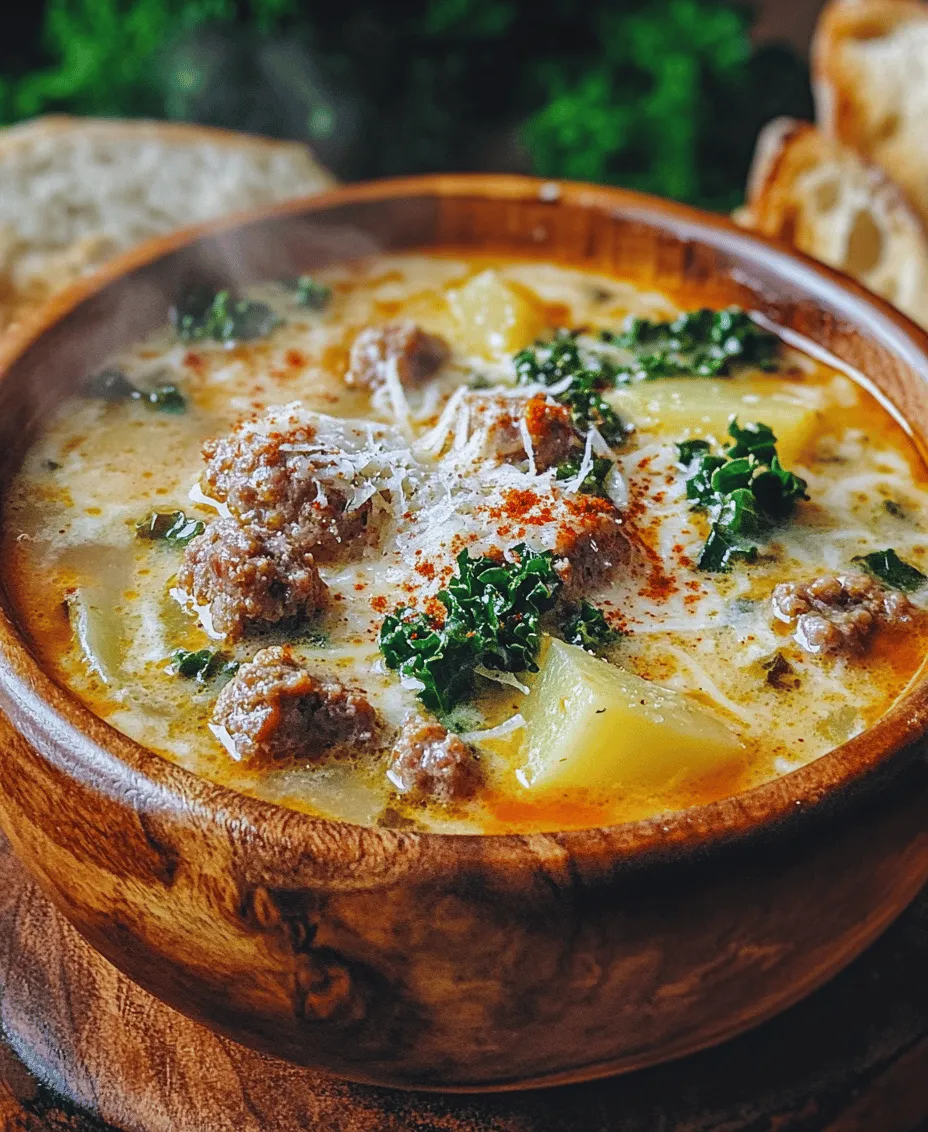Introduction
Understanding the rich culinary heritage of Italian cuisine can enhance your cooking experience, and there’s no better way to embrace this than through a bowl of Authentic Olive Garden Zuppa Toscana Soup. This comforting dish, known for its hearty blend of Italian sausage, fresh vegetables, and creamy broth, has captivated the hearts and palates of many. The Zuppa Toscana offers a delightful combination of flavors and textures that warms the soul and brings a taste of Italy right into your kitchen.
In this article, we will explore the origins of Zuppa Toscana, break down the recipe step-by-step, and discuss tips for customization, serving suggestions, and storage. Whether you’re a seasoned cook or a kitchen novice, this guide will equip you with everything you need to create this beloved soup at home.
The Origins of Zuppa Toscana
Exploring the Italian Roots of Zuppa Toscana
Zuppa Toscana, translating to “Tuscan Soup,” has deep roots in the rustic culinary traditions of Italy, particularly in the Tuscan region. Historically, Tuscan soups were designed to be hearty and filling, often utilizing ingredients that were readily available and affordable. These soups typically featured vegetables, beans, and grains, making them a staple for families who needed to feed their loved ones with minimal resources.
The evolution of Zuppa Toscana in American cuisine is particularly interesting. While the soup is inspired by traditional Italian recipes, it has undergone significant transformations to cater to American tastes. Olive Garden, an Italian-American restaurant chain, played a pivotal role in popularizing this dish across the United States. With its creamy texture and robust flavors, Zuppa Toscana quickly became a favorite among patrons, leading to its status as a signature dish on the restaurant’s menu. The cultural impact of this soup extends beyond just a meal; it reflects the blending of culinary traditions and the adaptability of Italian cuisine within American culture.
Ingredients Breakdown
Highlighting Key Ingredients and Their Roles
To craft an authentic Zuppa Toscana, understanding the key ingredients and their roles in the dish is essential. Each component contributes to the overall flavor profile and texture, creating the comforting bowl of soup that so many adore.
– Italian Sausage: The star of this dish, Italian sausage, is available in both spicy and mild varieties. The choice between the two can significantly influence the soup’s flavor. Spicy sausage adds a kick that complements the creaminess of the broth, while mild sausage delivers a more subtle flavor that allows the other ingredients to shine. For an authentic experience, look for high-quality sausage made with natural ingredients.
– Potatoes: Potatoes are crucial for adding texture and heartiness to Zuppa Toscana. Russet potatoes are preferred due to their starchy nature, which helps thicken the soup as they cook. Their fluffy interior absorbs the flavors of the broth, creating a deliciously comforting base.
– Kale vs. Swiss Chard: Traditionally, Zuppa Toscana features kale, a nutrient-rich leafy green that adds both color and flavor to the soup. Kale’s robust texture holds up well in the broth, providing a satisfying bite. Alternatively, Swiss chard can be used for a slightly milder taste and a tender texture. Both greens offer nutritional benefits, including vitamins A, C, and K, making them a healthy addition to your meal.
– Heavy Cream: The role of heavy cream in Zuppa Toscana cannot be overstated. It enriches the broth, creating a luscious and velvety texture that envelops each ingredient. The creaminess balances the robust flavors of the sausage and the earthiness of the vegetables. For a lighter version, half-and-half or milk can be substituted, but the richness may be compromised.
– Optional Ingredients: To elevate your Zuppa Toscana, considering optional ingredients such as Italian seasoning and red pepper flakes can enhance the flavor profile. Italian seasoning, a blend of herbs like oregano, basil, and thyme, adds depth to the dish. A pinch of red pepper flakes can introduce a pleasant heat that complements the sausage beautifully.
Step-by-Step Instructions for Authentic Zuppa Toscana
Detailed Cooking Process
Creating a bowl of Authentic Olive Garden Zuppa Toscana is a straightforward process that begins with preparing the base. Here’s how to bring this delicious soup to life:
1. Preparing the Base: Start by cooking the Italian sausage. In a large pot or Dutch oven, heat a drizzle of olive oil over medium heat. Once hot, add the sausage, breaking it apart with a wooden spoon. Cook until browned and cooked through, about 5-7 minutes. Ensure you achieve a nice sear on the sausage to develop rich flavors. Once done, remove the sausage from the pot and set it aside, leaving the rendered fat to flavor the next steps.
2. Sautéing Vegetables: In the same pot, add diced onions and minced garlic. Sauté until the onions become translucent and fragrant, about 3-4 minutes. This step is crucial for building the soup’s flavor foundation. Next, add diced carrots and celery, cooking for an additional 3-4 minutes until they begin to soften. The combination of these aromatic vegetables will create a delicious base for your soup.
3. Building the Soup: Once the vegetables are tender, return the cooked sausage to the pot. Add diced russet potatoes and enough chicken broth to cover the ingredients (about 6-8 cups). Bring the mixture to a boil, then reduce the heat to a simmer. Allow the soup to cook for approximately 20 minutes, or until the potatoes are tender. Stir occasionally to prevent sticking and ensure even cooking.
4. Achieving the Perfect Creaminess: When the potatoes are fork-tender, it’s time to create that signature creamy texture. Stir in chopped kale along with the heavy cream, and allow the soup to simmer for an additional 5-10 minutes. The kale will wilt down, adding vibrant color and nutrients while the cream enriches the broth. Taste and adjust seasoning with salt, pepper, and any additional Italian herbs as desired.
In this section, we have laid the groundwork for creating the beloved Zuppa Toscana soup, exploring its origins, essential ingredients, and the initial steps in the cooking process. By understanding each component and the cooking techniques involved, you will be well on your way to serving a delicious bowl of this Italian classic. Stay tuned for the continuation, where we will delve deeper into customization options, serving suggestions, and storage tips to make your Zuppa Toscana experience even more enjoyable.
Final Touches: Seasoning to Taste and Plating
Once your Zuppa Toscana is simmering and the aroma is filling your kitchen, it’s time for the final touches. Before serving, taste your soup and adjust the seasoning as necessary. Depending on your preference, you might want to add more salt, pepper, or even a dash of red pepper flakes for extra heat. Remember, seasoning is subjective; what tastes perfect to one person might need a little more oomph for another, so be generous in your tasting.
When it comes to plating, a rustic approach works wonders. Ladle the soup into large, warm bowls, ensuring each serving has a hearty portion of the kale, sausage, and potatoes. For an appealing finish, drizzle a little olive oil on top or add a dollop of sour cream or Greek yogurt for richness. A sprinkle of freshly grated Parmesan cheese elevates the dish, adding a savory touch that complements the soup beautifully. Lastly, garnish with a few fresh leaves of kale or a sprig of parsley for color. This not only enhances the visual appeal but also gives a nod to the fresh ingredients used in the recipe.
Nutritional Information
Understanding the health benefits of Zuppa Toscana can help you appreciate this dish even more. Here’s a breakdown of its nutritional highlights:
– Caloric Breakdown per Serving: One serving of Zuppa Toscana typically contains around 350-400 calories, depending on the specific ingredients used and portion sizes. This makes it a hearty yet manageable meal option for lunch or dinner.
– Key Nutrients from Each Ingredient:
– Kale: Packed with vitamins A, C, and K, kale is a nutrient powerhouse that supports immune function and skin health.
– Potatoes: A good source of potassium and fiber, potatoes provide energy and aid in digestive health.
– Italian Sausage: While delicious, it also contributes protein and iron, essential for muscle and overall body function.
– Cream: Adds a rich texture and flavor, though it should be consumed in moderation due to its saturated fat content.
– How to Make It Healthier: Substitutions and Modifications: If you’re looking to lighten your Zuppa Toscana, consider using low-fat milk or unsweetened almond milk instead of heavy cream. Additionally, swapping out the Italian sausage for turkey sausage or plant-based alternatives can significantly reduce the calorie and fat content while maintaining flavor.
Customization Options
Making Zuppa Toscana your own is part of the culinary joy. Here are some ideas to customize this classic dish:
– Vegetarian and Vegan Alternatives: For a vegetarian or vegan version, replace the sausage with plant-based sausage or lentils for protein. Use coconut milk or cashew cream instead of heavy cream to keep that creamy consistency without dairy.
– Spice Adjustments: Tailor the heat levels to your preference by adjusting the amount of red pepper flakes. For a milder soup, reduce the quantity or omit it entirely. If you like it spicy, consider adding diced jalapeños or a splash of hot sauce during cooking.
– Additional Ingredients: Feel free to incorporate other vegetables to enhance the flavor and nutrition profile of your soup. Adding canned beans, such as cannellini or chickpeas, introduces extra protein and fiber. Corn can add a touch of sweetness, and carrots or bell peppers can provide additional color and crunch.
Serving Suggestions
Creating the perfect meal experience with your Zuppa Toscana enhances the overall enjoyment. Here are some serving suggestions:
– Recommended Side Dishes: Pair your soup with crusty bread, such as a warm baguette or sourdough, to soak up the delicious broth. A light salad, such as a simple arugula salad dressed with lemon and olive oil, can also be a refreshing counterpart to the rich flavors of the soup.
– Presentation Tips: Serve the soup in rustic bowls for an authentic Italian feel. Consider placing a slice of lemon or a few olives on the side for a burst of color. Freshly cracked black pepper or an additional sprinkle of cheese can also be added at the table for guests to personalize their bowls.
Storage and Reheating Tips
To maximize the shelf life of your Zuppa Toscana and enjoy it longer, proper storage is key. Here are some tips:
– Proper Storage Methods for Leftovers: Allow the soup to cool completely before transferring it into airtight containers. It can be stored in the refrigerator for up to 4 days. For longer storage, consider freezing it in portions. Use freezer-safe containers or heavy-duty freezer bags, ensuring to remove excess air before sealing.
– Best Practices for Reheating: When reheating, do so gently on the stove over low heat. If the soup appears thickened after refrigeration, you can add a splash of vegetable broth or water to loosen it up. Stir occasionally and heat until warmed through. Avoid boiling, as this can alter the texture of the cream and other ingredients.
Conclusion
Authentic Olive Garden Zuppa Toscana Soup is more than just a meal; it’s a comforting dish that brings warmth and joy to the dining table. By following this comprehensive guide, you can create a soup that not only satisfies your taste buds but also embodies the essence of Italian cooking. Whether enjoyed on a chilly evening or shared with loved ones, this recipe promises to deliver a delightful culinary experience that will keep you coming back for more.
The ability to customize, adapt, and serve this soup with flair allows you to create a dish that reflects your personal tastes and dietary needs. So gather your ingredients, follow the steps outlined, and enjoy the rich, hearty flavors of Zuppa Toscana, a true comfort food classic.



